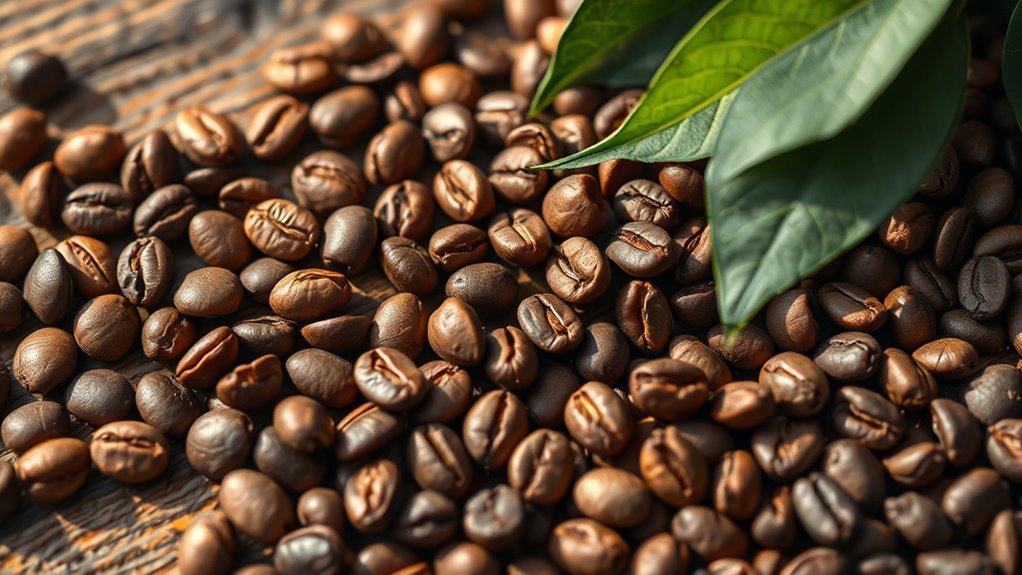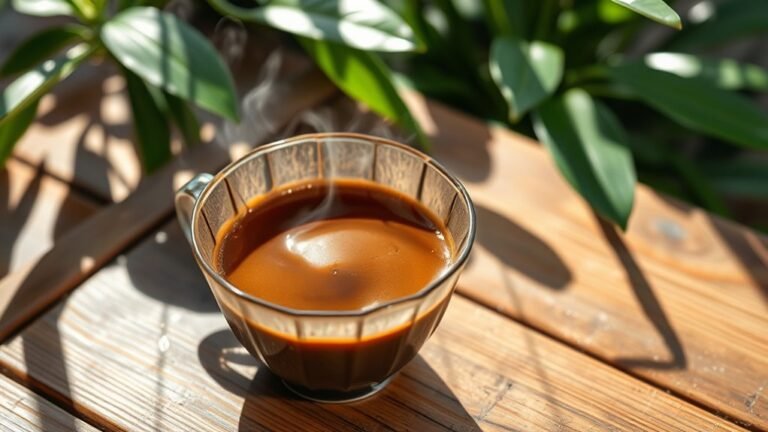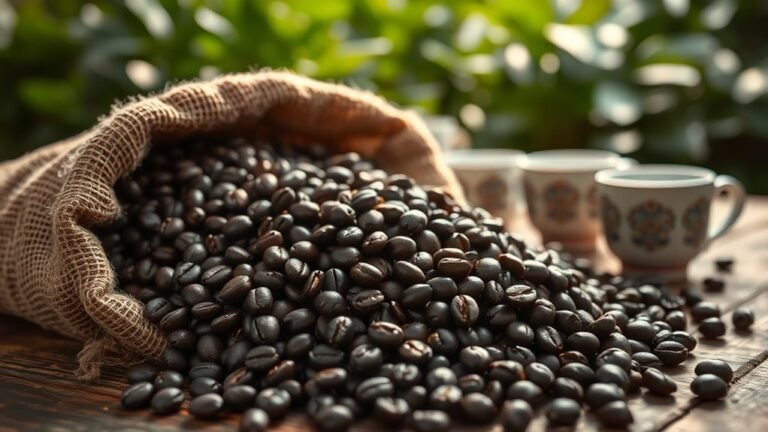A Beginner’s Guide to Coffee Beans: Arabica vs. Robusta
If you’re new to coffee, know Arabica beans come from higher altitudes with cooler climates, offering smooth, fruity flavors and less caffeine, while Robusta thrives in warmer, low-altitude areas, delivering a stronger, more bitter taste with double the caffeine. Arabica suits pour-over brewing for delicate notes, whereas Robusta stands up well to espresso’s boldness. Choosing between them depends on your flavor preference and caffeine needs—there’s much more to explore about these beans’ origins and health effects.
Understanding the Origins of Arabica and Robusta
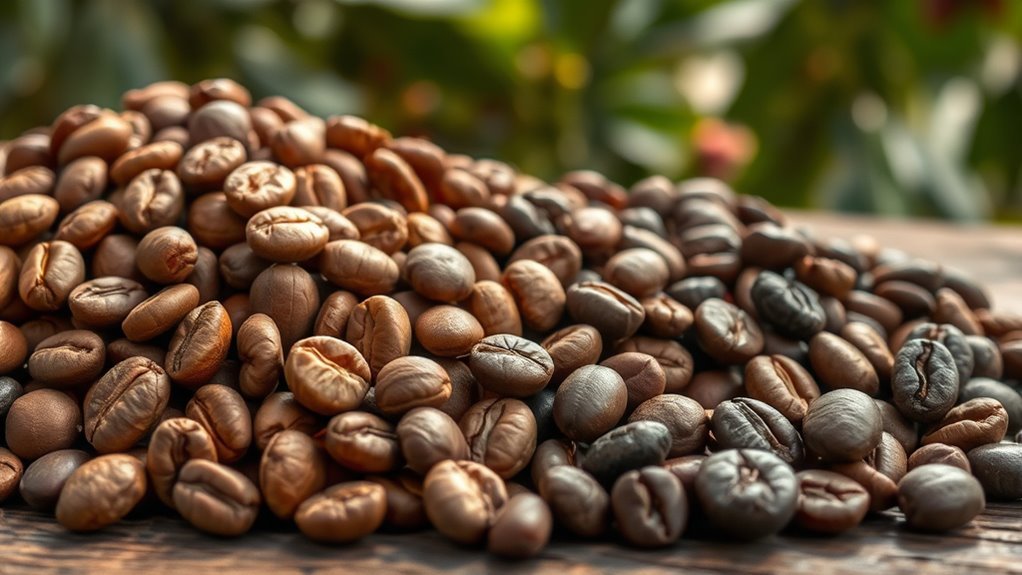
The origins of Arabica and Robusta coffee beans trace back to distinct regions and environments, which have shaped their unique characteristics. You’ll find Arabica’s history rooted in the highlands of Ethiopia, where cooler temperatures and higher altitudes create ideal growing conditions. This environment contributes to Arabica’s delicate profile and slower maturation. In contrast, Robusta cultivation thrives in the low-altitude, hotter climates of Central and Western Africa, and later Southeast Asia. Robusta plants are hardier, resistant to pests and diseases, and yield more fruit per hectare, making them better suited for intensive farming. Understanding these origins helps you appreciate how geography and climate influence each species’ growth, resilience, and agricultural demands, giving you the freedom to choose beans that align with your preferences and values.
Flavor Profiles and Taste Differences
Although both Arabica and Robusta beans come from the coffee family, you’ll notice distinct differences in their flavor profiles that cater to varying palates. Arabica beans offer complex flavor nuances, often described by tasting notes of fruit, floral, and sweet undertones, with a smooth, balanced acidity. This makes them ideal if you appreciate subtlety and refinement in your cup. On the other hand, Robusta presents a stronger, more robust flavor with earthy, woody, and sometimes bitter tasting notes. It’s also known for a heavier body and higher caffeine content, which can give your coffee a bold punch. Understanding these flavor nuances helps you choose a coffee experience that matches your taste preferences and freedom to explore different profiles.
Growing Conditions and Plant Characteristics
When you consider where and how coffee plants thrive, Arabica and Robusta reveal significant differences that impact their cultivation and final quality. Arabica prefers higher elevations, between 1,200 and 2,200 meters, flourishing in cooler climates with rich, volcanic soil. Its susceptibility to plant diseases like coffee leaf rust demands careful cultivation techniques, including shade management and pruning. Robusta, on the other hand, grows well at lower altitudes, around sea level to 800 meters, and tolerates hotter, wetter environments. It’s hardier, resisting many plant diseases that trouble Arabica, which simplifies its cultivation techniques and allows for higher yields. Understanding these distinct growing conditions and plant characteristics helps you appreciate how environmental factors and farming practices shape the beans you enjoy, offering you freedom to choose the coffee that suits your preferences.
Caffeine Content and Health Impacts
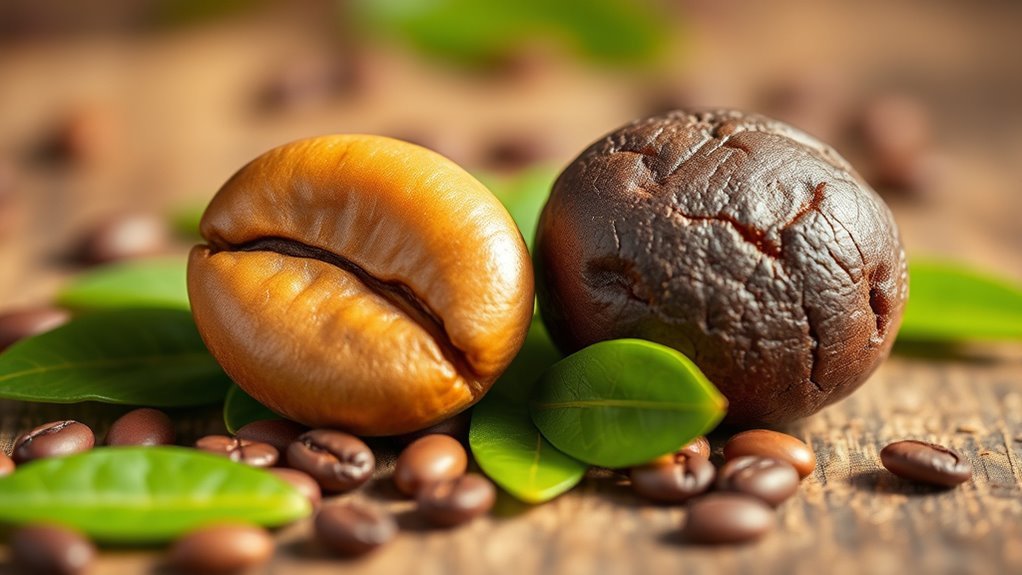
Having explored how Arabica and Robusta adapt to their environments, it’s important to contemplate how these differences extend to their caffeine content and the effects on your health. Robusta beans generally contain about twice the caffeine of Arabica, meaning you’ll experience stronger caffeine effects with Robusta. This higher caffeine level acts as a natural pest deterrent and contributes to its bitter flavor. For you, caffeine’s stimulating properties can enhance focus and alertness, but too much may cause jitters or anxiety. Both beans offer health benefits, including antioxidants that support heart health and reduce inflammation. Choosing between Arabica and Robusta isn’t just about taste—it’s about how you want caffeine to impact your body and mind, giving you the freedom to tailor your coffee experience to your lifestyle and wellness goals.
Choosing the Right Bean for Your Coffee Preferences
How do you decide which coffee bean suits your taste and lifestyle best? Start by exploring bean variety choices: Arabica offers delicate, nuanced flavors with lower caffeine, ideal if you prefer a smoother cup. Robusta delivers a stronger, more bitter profile with higher caffeine, perfect for a bold, energizing boost. Next, consider your brewing methods—Arabica shines in pour-over or drip, highlighting its subtle notes, while Robusta’s robustness stands up well to espresso and French press. Your daily routine and flavor preference guide your selection, letting you embrace freedom in every cup. By matching beans to your brewing style and desired taste, you gain control over your coffee experience, crafting a brew that aligns with your unique palate and lifestyle.
Frequently Asked Questions
How Should I Store Coffee Beans to Keep Them Fresh?
To keep your coffee beans fresh, you’ll want to store them in airtight containers to prevent exposure to air, which can degrade their flavor. Humidity control is essential—avoid places with high moisture, as it can cause beans to spoil or lose their aroma. Store the container in a cool, dark spot away from heat and sunlight. This way, you preserve the beans’ quality, letting you enjoy rich, flavorful coffee whenever you brew.
What Is the Best Grind Size for Arabica vs. Robusta Beans?
You’ll want to adjust your grind consistency based on the bean type and brewing methods you prefer. Arabica beans benefit from a medium to medium-fine grind, ideal for drip or pour-over, highlighting their nuanced flavors. Robusta, being stronger and denser, works well with a coarser grind for French press or a finer grind for espresso, extracting boldness without bitterness. Experiment a bit to match your taste and freedom in brewing style.
Can I Blend Arabica and Robusta Beans for Brewing?
Did you know that over 60% of commercial coffee blends combine Arabica and Robusta beans? You can definitely blend these beans to achieve a unique flavor balance. By mastering blending techniques, you control bitterness, body, and acidity, tailoring your brew to your taste. Experiment with ratios to find your perfect mix—whether you want a smoother cup or a bolder kick. Blending opens up freedom to craft coffee that truly suits you.
How Do Roasting Levels Affect Arabica and Robusta Flavors?
Roasting profiles deeply influence the flavor notes you get from your coffee. With Arabica, lighter roasts highlight fruity and floral notes, while darker roasts bring out chocolatey, caramel tones. Robusta, on the other hand, tends to develop nuttier, earthier flavors as it darkens, often with a stronger bitterness. By adjusting roasting levels, you can tailor the taste experience, giving you the freedom to enjoy everything from bright acidity to bold, robust richness.
Are There Any Ethical Concerns With Sourcing Arabica or Robusta?
Imagine lush, thriving farms beside exploited labor fields—that’s the reality behind some coffee sourcing. When you choose sustainably sourced, fair trade Arabica or Robusta, you support ethical practices that protect farmers’ rights and the environment. Without fair trade certification, workers may face unfair wages and poor conditions. So, if you want freedom in your coffee choices, prioritize beans from transparent, responsible sources that promote sustainability and social equity.
